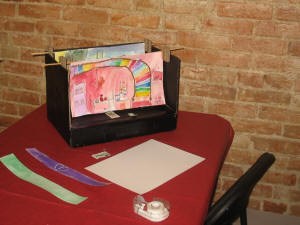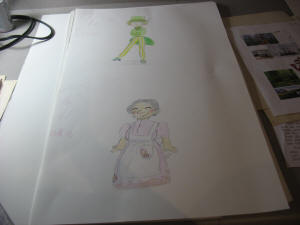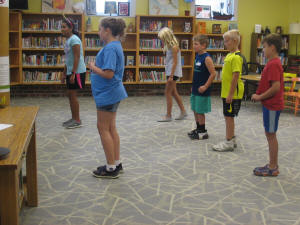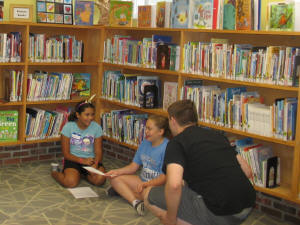|
 The camp was led by Jean Kerr along with several
assistants. Kerr chairs the School of Theater Arts at Illinois
Wesleyan University. Her area is movement, which includes dance,
physical characterization, masks, and stage combat. Kerr also
choreographs and directs theatrical performances. The camp was led by Jean Kerr along with several
assistants. Kerr chairs the School of Theater Arts at Illinois
Wesleyan University. Her area is movement, which includes dance,
physical characterization, masks, and stage combat. Kerr also
choreographs and directs theatrical performances.
Kerr said at the camp, the children usually build a script, but this
year, they built their theatrical skills. One thing Kerr and her
assistants have been doing is teaching them to “Shuffle off to
Buffalo.” In addition, they have worked on active listening,
physical listening, and the design process for the scenic world and
costumes for the characters.

Each child took one of Aesop’s Fables and created a different story
with at least two different characters and two different scenes.


For instance, one child took the story of “The ant and the
grasshopper” and made it a futuristic story with the terminator as
the grasshopper, the Antman character from Marvel Comics as the Ant,
and a robot version of Abraham Lincoln.
Another child did the story of “Mercury and the Woodman” where a
woodman goes out to the woods to chop down trees and loses his ax.
Mercury finds three axes and asks the woodman if each one is his,
but the woodman says only the final one is his, so he is rewarded
with all three axes. When others pretend to lose their axes, Mercury
knows they are lying. The moral of the story is honesty is the best
policy.
Library Director Cathy Maciariello said the children made
storyboards and scenes using these stories. She said they were
trying to show the children all that goes on before a play is
performed. Instead of the performance aspects, children learned
about the complexities of creating a play.
Kerr said the children did worksheets on story plots, scenic design,
and costume concepts. They had to do design homework and research,
then find pictures to help inspire their scenes.
Maciariello said the children became scene designers, costume
designers, and set designers. Children have been working on scenes all
week and making a three-dimensional theater, or model, box.

Linnea, who helped with costume designs, said each child created the scenes for
their stories and designed the characters and their costumes.
[to top of second column] |

On Thursday, they hung the scenes in their model boxes. Kerr said
they all made some great models.

Another part of the day was spent playing theater games and Kerr taught them
some games she has done with her theater students. One game focused on time with
the children first running quickly across the room and then moving as slowly as
they could. Kerr told them to move like a snail in the garden or like they were
walking in thick, warm mud.

After the games, the children paired up to read their poetry. Kerr said the
children wrote poems based on something that had happened to this summer. To
create the poem, they had to write sentences that rhymed. Assistant Danielle had
the pairs read their own poems to one another then read each other's poems out
loud. For Friday, they had to memorize someone else’s poem and recite it.
The children then did dances led by assistant Carson, who taught them steps of
Tap dance. They first worked on a heel drop and steps, then added in hops and
leaps when the music played. Other steps they learned were scuffle, spank,
brush, and shuffle.
They ended Thursday’s lesson by marching in time to the beat. By Friday, they
had to do a dance with all the steps together.

The final activity on Thursday was costume design. Using ideas they had
researched for costumes, the children chose costumes that worked with their
characters and then designed, drew, and colored the costumes.
The children at the Theater Discovery Camp learned many theatrical skills used
in performance as they discovered all the work that goes into theatrical
performance.
[Angela Reiners]
 |